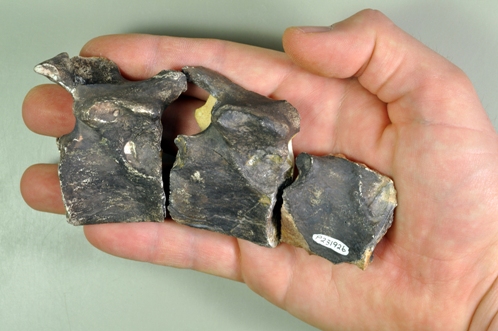Ancient Fossils from New Guinea Help Scientists to Understand Distribution of Prehistoric Sea Cows
A gap in Australasia’s marine evolutionary record has been filled by a group of sea cow fossils recently identified by museum scientists as the oldest ever found in the region. The 12-million-year-old fossils were discovered in a cave under the remote central highlands of New Guinea more than 30 years ago, but remained unstudied. Last year, they were rediscovered in a museum drawer by scientists from Museum Victoria and the Smithsonian Institution, who immediately found the fossils curious.
Australian Sea Cow
Examples of the Fossil Material Discovered in the Cave (Vertebrae)
Picture credit: Dr Erich Fitzgerald
Dr Erich Fitzgerald, Museum of Victoria’s Senior Curator of Vertebrate Palaeontology stated:
“Until now, Australasia didn’t have a particularly ancient fossil record of sea cows, the group of marine mammals that includes our living dugongs. The records only went back some five million years. Elsewhere in Asia, sea cow fossils are found in much older rocks, so it was always a mystery as to why the fossils hadn’t been found in this part of the world. Now, with this one discovery, we’ve more than doubled the length of their evolutionary history in Australasian seas.”
A Vital Perspective
Dr Fitzgerald says the fossils provide a vital perspective on the relationship modern sea cows have with Australia’s northern marine ecosystems.
He went onto add:
“Modern-day dugongs are major consumers of sea-grass, and, by doing so, have a tremendous impact on the structure of the ecosystem. They participate in a delicate balancing act: their feeding allows diversity in sea-grass and animal species that would otherwise be lacking.”
Studying the Fossils
Until this drawer of fossils was studied, it had been thought that sea cows were fairly recent arrivals in Australasian waters and that these grazers and their relationship with sea-grass ecosystems around Australian waters was also recent. This new research suggests that these gentle giants have been an important part of Australasia’s marine ecosystems for at least twelve million years and that their role in the long-term health of these environments may be very significant.
Everything Dinosaur is grateful for the Museum Victoria for their assistance in compiling this news story.
For models and replicas of prehistoric animals from Australia and elsewhere in the world: CollectA Age of Dinosaurs Popular Models.






Leave A Comment